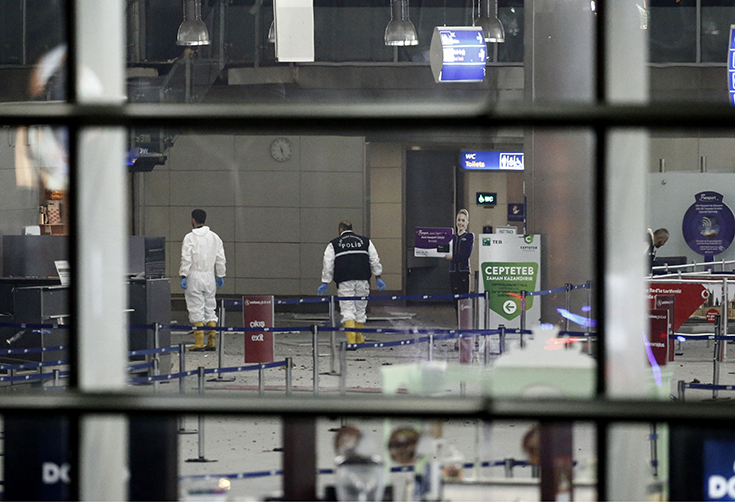Lessons learnt from airport terrorist attacks
CRJ Editorial Advisory Panel Member Lina Kolesnikova recently took part in the annual Critical Infrastructure Protection and Resilience Europe conference in the Hague, the Netherlands. Here, she summarises her presentation on lessons learnt from the terrorist attacks at Zaventem (Brussels) and Ataturk (Istanbul) international airports.

Police investigators search the area after a suicide bomb attack at Ataturk Airport in Istanbul, Turkey, on June 28, 2016. At least ten people were killed in two separate explosions. As airside areas at airports are made safer, does this have a converse effect on security landslide? (photo: Sedat Suna /Epa/REX/Shutterstock
On March 22, Brussels observed the first anniversary of double terrorist attacks at the airport of Zaventem and Maelbeek underground station. June 28, 2017 marked one year after the terrorist attack on its premises.
Airports always attract terrorists and this situation has not changed in the last year, as we have witnessed several significant terrorist attacks on airports.
Huge investment into sophisticated equipment for individual passenger checks before boarding has resulted in a lack of security measures for the physical protection of people on the ground. Airports currently prioritise airside security, or the area accessible only to airport staff and passengers with boarding cards. Effectively, the by-product of this improvement airside makes landside insecurity greater. Long queues of people waiting for pre-flight security checks, as well as at check-in, are tempting targets for terrorists. Flight departures and arrival information can also ‘help’ terrorists to target certain nationalities at counters of air carriers, at check-in desks or in arrival halls.
In its nature, the Brussels attack was similar to the Paris attack on November 13, 2015. The group of terrorists split into two parts for simultaneous attacks of different targets. However, it was fulfilled by a less prepared group with fewer resources than those in Paris.
The response to simultaneous attacks is quite a challenge. Lack of information efficient communication, unpredictability of the overall situational development and, often, insufficient interagency co-operation and coordination – are only some of issues that can arise at a time of very complex response activities. In addition, the Belgian authorities did not have much experience with counter-terrorism response.
In Istanbul there were three terrorists, who opened a fire next to the x-ray scanner. Screening at Ataturk had been pushed all the way back to the terminal entrances. This is the so-called Moscow model of security, which was introduced in many airports after Domodedovo attack. However, this model creates crowds at terminal entrances that can be targeted and indeed, this is what appears to have happened at Ataturk. If there is going to be screening, it has to be done somewhere, and therefore some crowding somewhere is inevitable.
According to Turkish officials, a third attacker set one of the explosions off in the parking lot across the street from the terminal. Turkish law enforcement also insisted that the terrorists planned to take hostages among passengers and to play out a Mumbai scenario. At the beginning of the attack, the terrorists were mistaken for thieves so the reaction of security personnel was more relaxed.
Lessons learnt
One interesting aspect is the origin of the terrorists. The attackers at Istanbul were from Russia's North Caucasus region and the others from Uzbekistan and Kyrgyzstan. So we are seeing more and more terrorists from the ex-Soviet Union, of Central Asian or Russian origin (Caucasus). There are other terrorist attacks which come to mind: Boston marathon bombing (Chechen origin), night club Istanbul bombing (Uzbek national), Stockholm (Uzbek national), St-Petersburg (Kyrgyz origin, Russian naturalisation), the failed terrorist plot in Norway (Chechen refugee). A further dangerous pattern is that operatives from Central Asia are more frequently become suicide bombers.
Terrorists in Brussels continue this dangerous pattern when operatives come from the same family or circle of very close friends. To prevent such attacks is practically impossible. Family members are extremely loyal to one another and practically never inform the police about terrorist plots.
Technically, the composition of both attacks is the same, as it involves penetration of the area where crowds are, and acting violently.
The terrorists in Brussels were known to the intelligence authorities and were on the wanted lists of several countries. Unfortunately information was not shared between law enforcement and airport authorities, and the airport did not have an appropriate facial recognition system.
Airports should rely on risk-based and proportionate security with a holistic approach. In these days of economic pressure, now is the time to be looking for origin solution and out-of-box ideas in security. The perfect security solutions should be passenger-friendly and of low visibility to non-security personnel.
Unfortunately many airports, backed by governments, go in the opposite direction – we see a high presence of military and law enforcement personnel who are heavily armed.
Security personnel should be equipped, not only with lethal weapons, but also with various other non-lethal techniques that might be more appropriate when employed in crowded space.
What makes these attacks deadly and so harmful is the presence of crowds in open spaces. Once the security bar has been raised, and personnel equipped, passenger protection must lie at the heart of security.
There is an urgent need for airport operators to build stronger relationships with national regulators. Collaboration with the local or national authorities responsible for security of landside spaces is crucial; in many instances airports own the real estate landside, but the responsibility for public spaces lies with local law enforcement.
Lina Kolesnikova, 16/05/2017